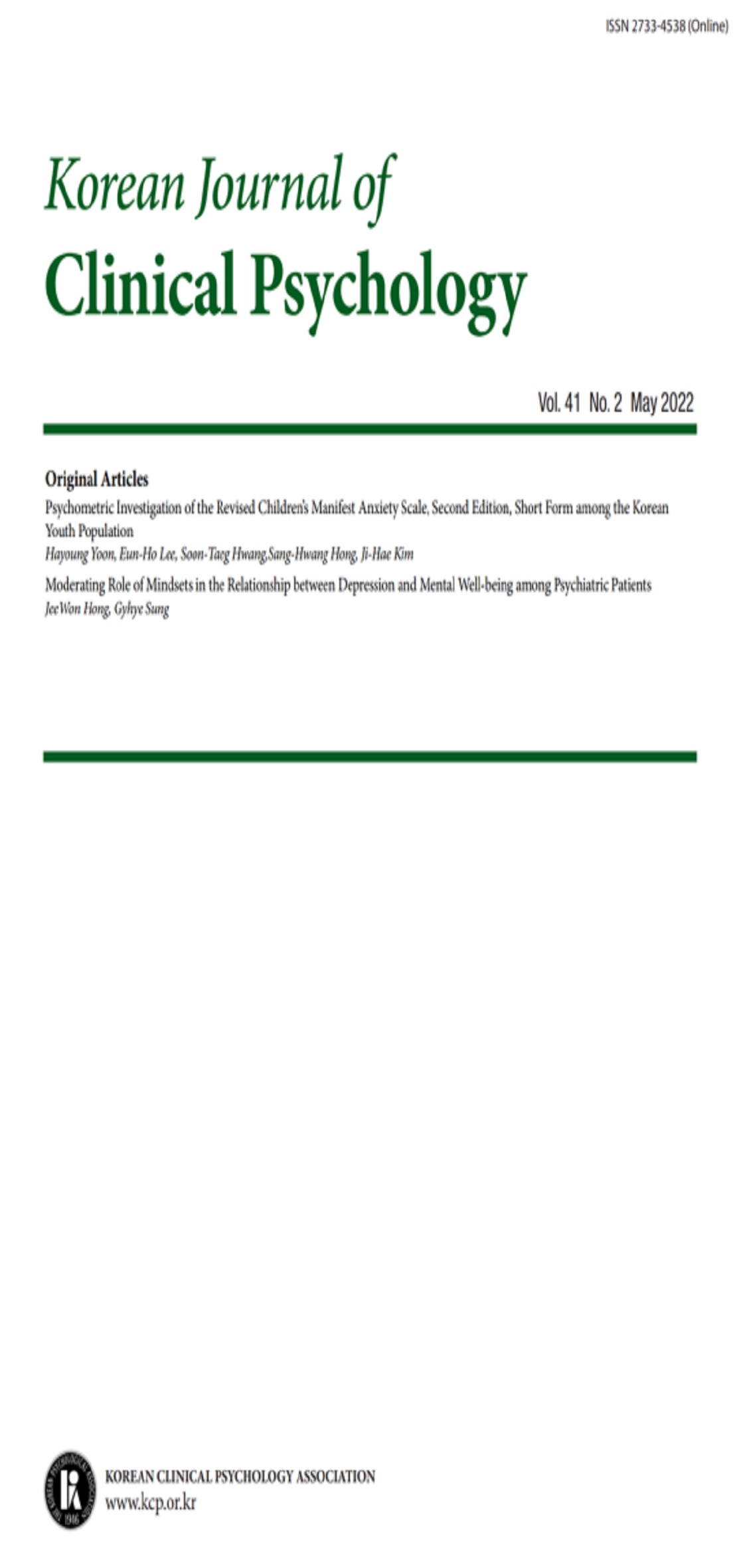open access
메뉴
open access
메뉴 E-ISSN : 2733-4538
E-ISSN : 2733-4538
본 연구는 외현적 자기애와 내현적 자기애로 자기애 하위 유형을 구분하여 각 하위 유형의 자존감 불안정성을 비교하였다. 대학생 345명 중 외현적 자기애 집단, 내현적 자기애 집단, 통제 집단을 선발한 후 일상적인 자존감 수준, 평가적 피드백이 주어지는 가상 상황에서의 자존감 수준, 일일보고과제를 통해 실생활에서 주요 사건에 따른 자존감 변화를 측정하였다. 연구 결과, 평가적 피드백 시나리오 상황에서 자기애성향자들은 통제 집단보다 유의미하게 큰 자존감 변화를 보고하였고, 그 정도는 내현적 자기애성향자들이 외현적 자기애성향자들보다 더 컸다. 일일보고과제에서는 내현적 자기애성향자들이 외현적 자기애 집단과 통제 집단에 비해 더 큰 자존감 변화를 보이는 경향성이 있었으나 집단 간 차이가 유의미하지 않았다. 본 연구에서 관찰된 자기애성향자들의 자존감 불안정성을 이전의 임상적 관찰 및 경험적 연구 결과에 비추어 논의하였고, 본 연구의 시사점과 제한점을 논의하였다.
In this study, the self-esteem instability of overt and covert narcissists was investigated. Thirty-three overt narcissists, 45 covert narcissists, and 67 controls were selected from 345 college students. The self-esteem scale along with scenario questionnaires was administered to evaluate self-esteem instability under virtual situations where evaluative feedback was given. Lastly, to evaluate self-esteem instability in natural situations, the three groups were asked to send in a diary by e-mail detailing their major life events and self-esteem every night for 5 days. Under the context of virtual evaluative feedback, covert narcissists showed significantly higher self-esteem than the overt narcissists and both narcissistic groups showed significantly higher self-esteem compared to controls. In natural situations, although not statistically significant, narcissist groups showed a tendency of exhibiting unstable self-esteem compared to controls, and the highest instability was present in covert narcissists. The results of this study are discussed from the perspective of clinical observation and advanced research. The key findings and limitations of the present study are also discussed.
강선희, 정남운 (2002). 내현적 자기애 척도의 개발 및 타당화 연구. 한국심리학회지: 상담 및 심리치료, 14(4), 969-990.
박세란 (2004). 외현적 내현적 자기애의 자기평가와 귀인양식. 서울대학교 대학원 석사학위청구논문.
이훈진, 원호택 (1995). 편집증적 경향, 자기개념, 자의식 간의 관계에 대한 탐색적 연구. 한국심리학회 ‘95연차대회 학술발표논문집, 277-290.
한수정 (1999). 자기애 성격성향자의 외현적, 내현적 자기관련 인지특성. 서울대학교 문학석사 학위논문.
황순택 (1995). 전형성 평정에 의한 성격장애 진단준거 개발. 연세대학교 대학원 심리학박사 학위논문.
Akhtar, S., & Thompson, A. (1982). Overview: Narcissistic Personality Disorder. American Journal of Psychiatry, 139, 12-20.
Bushman, B. J., & Baumeister, R. F. (1998). Threatened egotism, narcissism, self-esteem, and direct and displaced aggression: Does self-love or self-hate lead to violence? Journal of Personality and Social Psychology, 75, 219-229.
Campbell, W. K., Rudich, E. A., & Sedikides, C. (2002). Narcissism, self-esteem, and the positivity of self-views: two portraits of self-love. Personality and Social Psychology Bulletin, 28, 358-368.
Kernberg, O. F. (1984). Severe personality disorders: Psychotherapeutic strategies. New Haven: Yale University Press.
Kernis, M. H., Lakey, C. E., & Heppner, W. L. (2008). Secure versus fragile self-esteem as a predictor of verbal defensiveness: Converging findings across three different markers. Journal of Personality, 76, 477-512.
Kernis, M. H., & Sun, C. (1994). Narcissism and reactions to interpersonal feedback. Journal of Research in Personality, 28, 4-13.
Kohut, H. (1971). The analysis of the self. New York: International Universities Press.
Paulhus, D. L. (1998). Interpersonal and intrapsychic adaptiveness of trait self- enhancement: A mixed blessing? Journal of Personality and Social Psychology, 74, 1197-1208.
Rathvon, N., & Holmstrom, R. (1996). An MMPI-2 portrait of narcissism. Journal of Personality Assessment, 66, 1-19.
Rhodewalt, F., Madrian, J. C., & Cheney, S. (1998). Narcissism, self-knowledge organization, and emotional reactivity: The effect of daily experience on self-esteem and affect. Personality and Social Psychology Bulletin, 24, 75-87.
Rhodewalt, F., & Morf, C. C. (1998). On self-aggrandizement and anger: A temporal analysis of narcissism and affective reaction to success and failure. Journal of Personality and Social Psychology, 74(3), 672-685.
Rose, P. (2002). The happy and unhappy faces of narcissism. Personality and Individual Differences, 33, 379-391.
Rosenberg, M. (1965). Society and the adolescent self-image. Princeton, NJ: Princeton University Press.
Zeigler-Hill, V., Chadha, S., & Osterman, L. (2008). Psychological defense and self-esteem instability: Is defense style associated with unstable self-esteem? Journal of Research in Personality, 42, 348-364.
Zeigler-Hill, V., Myers, E. M., & Clark, C. B. (2010). Narcissism and self-esteem reactivity: The role of negative achievement events. Journal of Research in Personality, 44, 285-292.
